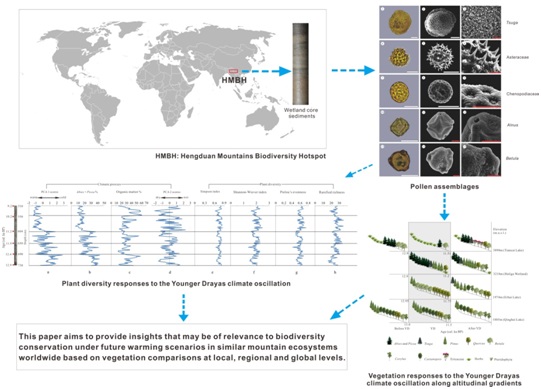The Younger Dryas (YD, ca. 12.8–11.5 cal. ka BP) is one of the most abrupt climatic events in Earth's recent history. The warming at the end of the YD, in particular, is considered to be comparable to the global warming seen in the 21st century predicted by IPCC. Therefore, the study on YD event and its environmental effect is helpful to address the hot issue of social concern “Climate warming is a blessing or a disaster”.
However, most reports have focused on YD event at high and middle latitudes with few studies at low latitudes. Specifically, the abrupt warming at the YD termination and its biological effect received significantly little attention.
Researchers from Institute of Botany of Chinese Academy of Sciences and Royal Botanic Garden Edinburgh present a continuous, well-dated pollen sequence and loss-on-ignition data (12.9–9.2 cal. ka BP) from Haligu wetland in the Hengduan Mountains of Southwestern China, a low latitude temperate biodiversity hotspot.
The researchers aimed to 1) improve understanding of the YD climatic reversal and late glacial-Holocene transition in the Hengduan Mountains, 2) present evidence for a rapid response in the diversity and composition of vegetation to the warming at the YD termination, and 3) provide a past analog for biotic responses to potential climatic developments similar to the rapid climatic shifts seen in the YD-Holocene under near-future global warming caused by anthropogenic activity.
Based on the relationship between pollen and vegetation, the researchers reconstructed the history of vegetation dynamics and climate change during 12.9–9.2 cal. ka BP, and found that the relative abundance, concentration and influx of subalpine coniferous pollen (e.g., Abies, Picea) kept high values in the YD cooling event.
When climate became warming at the end of the YD, the relative abundance, concentration and influx of these coniferous pollen decreased sharply, accompanied by an increase in coverage of generally temperate taxa such as Quercus and Betula, and a distinct rising in plant taxonomic diversity.
The research reveals that shifts in hydrothermal combination induced by future warming and glacier melting may trigger the changes in plant diversity of this region and elevation displacement of temperature-sensitive plant taxa. This finding provides insights that may be of relevance to biodiversity conservation under future warming scenarios in similar mountain ecosystems worldwide.
The study entitled "Vegetation responses to the warming at the Younger Dryas-Holocene transition in the Hengduan Mountains, southwestern China" has been published in Quaternary Science Reviews.  Climate warming triggered historical vegetation change in the Hengduan Mountains ArticleLink: https://doi.org/10.1016/j.quascirev.2018.06.007
Climate warming triggered historical vegetation change in the Hengduan Mountains ArticleLink: https://doi.org/10.1016/j.quascirev.2018.06.007 CONTAC INFO:
Institute of Botany, Chinese Academy of Sciences,
20 Nanxincun, Xiangshan, Beijing 100093, China
E-mail: Int_office@ibcas.ac.cn
The Younger Dryas (YD, ca. 12.8–11.5 cal. ka BP) is one of the most abrupt climatic events in Earth's recent history. The warming at the end of the YD, in particular, is considered to be comparable to the global warming seen in the 21st century predicted by IPCC. Therefore, the study on YD event and its environmental effect is helpful to address the hot issue of social concern “Climate warming is a blessing or a disaster”.
However, most reports have focused on YD event at high and middle latitudes with few studies at low latitudes. Specifically, the abrupt warming at the YD termination and its biological effect received significantly little attention.
Researchers from Institute of Botany of Chinese Academy of Sciences and Royal Botanic Garden Edinburgh present a continuous, well-dated pollen sequence and loss-on-ignition data (12.9–9.2 cal. ka BP) from Haligu wetland in the Hengduan Mountains of Southwestern China, a low latitude temperate biodiversity hotspot.
The researchers aimed to 1) improve understanding of the YD climatic reversal and late glacial-Holocene transition in the Hengduan Mountains, 2) present evidence for a rapid response in the diversity and composition of vegetation to the warming at the YD termination, and 3) provide a past analog for biotic responses to potential climatic developments similar to the rapid climatic shifts seen in the YD-Holocene under near-future global warming caused by anthropogenic activity.
Based on the relationship between pollen and vegetation, the researchers reconstructed the history of vegetation dynamics and climate change during 12.9–9.2 cal. ka BP, and found that the relative abundance, concentration and influx of subalpine coniferous pollen (e.g., Abies, Picea) kept high values in the YD cooling event.
When climate became warming at the end of the YD, the relative abundance, concentration and influx of these coniferous pollen decreased sharply, accompanied by an increase in coverage of generally temperate taxa such as Quercus and Betula, and a distinct rising in plant taxonomic diversity.
The research reveals that shifts in hydrothermal combination induced by future warming and glacier melting may trigger the changes in plant diversity of this region and elevation displacement of temperature-sensitive plant taxa. This finding provides insights that may be of relevance to biodiversity conservation under future warming scenarios in similar mountain ecosystems worldwide.

CONTAC INFO:
Institute of Botany, Chinese Academy of Sciences,
20 Nanxincun, Xiangshan, Beijing 100093, China
E-mail: Int_office@ibcas.ac.cn
